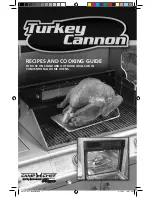
16
USE AND CARE INSTRUCTIONS
CORRECT LP GAS TANK USE
The LP Gas tank must be constructed and marked in
accordance with the Specifications for LP-Gas Cylinders
of the U.S. Department of Transportation (D.O.T.) or the
National Standard of Canada, CAN/CSA-B339, Cylinders,
Spheres and Tubes for Transportation of Dangerous
Goods and Commission; as applicable.
The LP Gas tank must have a shutoff valve, terminating
in an LP Gas supply tank valve outlet, that is compatible
with a Type 1 tank connection device. The LP Gas tank
must also have a safety relief device that has a direct
connection with the vapor space of the tank.
The tank supply system must be arranged for vapor
withdrawal.
The LP Gas tank must have a collar to protect the tank
valve.
Never connect an unregulated LP gas tank to your gas
grill. The gas regulator assembly supplied with your gas
grill is adjusted to have an outlet pressure of 11" water
column (W.C.) for connection to an LP gas tank. Only
use the regulator and hose assembly supplied with your
gas grill. Replacement hose and regulator assembly
must be identical to those listed in the parts list of this
Operator's Manual as specified by Grand Hall.
Have your LP Gas dealer check the release valve after
every filling to ensure it remains free of defects.
Always keep LP Gas tank in upright position.
Do not subject the LP Gas tank to excessive heat.
Never store an LP Gas tank indoors. If you store your
gas grill in the garage always disconnect the LP Gas
tank first and store it safely outside.
LP Gas tanks must be stored outdoors in a well-
ventilated area and out of the reach of children.
Disconnected LP Gas tanks must not be stored in a
building, garage or any other enclosed area.
The regulator and hose assembly can be seen by
opening the Island Cabinet. They must be inspected
before each use of the grill. If the hose is damaged in
any way, it must be replaced prior to using the grill again.
Any attempt to convert the grill from one fuel type to
another is extremely hazardous and will void the war-
ranty.
Never light your gas grill with the lid closed or before
checking to ensure the burner tubes are fully seated over
the gas valve orifices.
Never allow children to operate your grill. Do not allow
children or pets to play near your grill. Always supervise
children and pets if they are in the vicinity of the unit.
Never
use charcoal or lighter fluid in this grill.
Use of alcohol, prescription or non-prescription drugs
can impair your ability to properly assemble and
safely operate your grill.
Keep fire extinguisher readily accessible. In the event
of a oil/grease fire, do not attempt to extinguish with
water. Use type B extinguisher or smother with dirt,
sand or baking soda.
In the event of rain, turn off the burners and gas
supply. Wait for the grill to cool, and then place a
cover on it.
Use your grill on a level, stable surface in an area
clear of combustible materials.
LP Gas grill models are designed for use with a standard
20 lb. Liquid Propane Gas (LP Gas) tank (sold sepa-
rately).
Never
connect your gas grill to an LP Gas tank
that exceeds this capacity. A tank of approximately 12
inches in diameter by 18-1/2 inches high is the maximum
size LP Gas tank to use.
You must use an
"
OPD" gas
tank which offers a listed Overfill
Prevention Device.
This safety feature prevents tank from being overfilled
which can cause a malfunction of the LP Gas tank.
Do not leave grill unattended when in use.
Do not move the appliance when in use.
Allow the grill to cool before moving or storing.
Do not use your grill as a heater.
Never use your gas grill on a balcony, deck, patio
above the ground floor of your home.
This grill is not intended to be installed in or on
recreational vehicles and/or boats.
The grill is not intended for commercial use.
!
Do not store a spare LP-Gas tank under or near
this appliance.
Never fill the tank beyond 80 percent full; and
If the information in "(a)" and "(b)" is not followed
exactly, a fire causing death or serious injury may
occur.
A.
B.
C.
WARNING
!
!
WARNING
!
Refer to the this table when designing the island unit
for the BTH2610ALP/NG & BTH3210LLP/NG. Side*
and Rear* show the minimum amount of distance the
unit must be from combustibles (ex. Vinyl or wood
siding, fences and overhangs) or sources of ignition
(ex. Pilot lights on water heaters and live electrical
appliances). Height* shows the minimum height the
island unit must be starting from the ground up.
Side*
Depth
Height
Width
Non-combustible
Construction
Rear*
7" minimum
clearance from
cutout (for lid)
Height*
Model
Height
Width
Depth
Side* Rear* Height*
BTH2610
ALP/NG
9-1/2" 24-1/2" 19-3/4"
36"
36"
29"
BTH3210
LLP/NG
9-1/2" 30-1/2" 19-3/4"
36"
36"
29"
















































